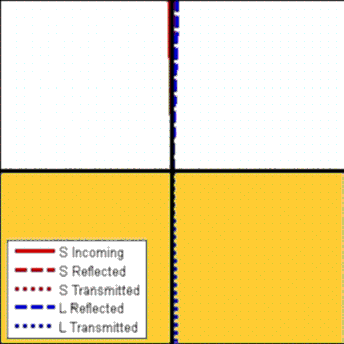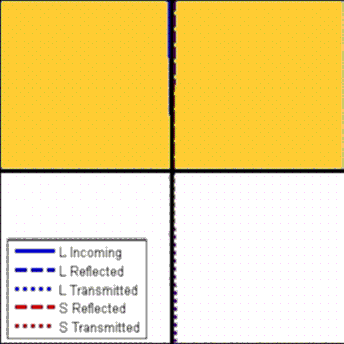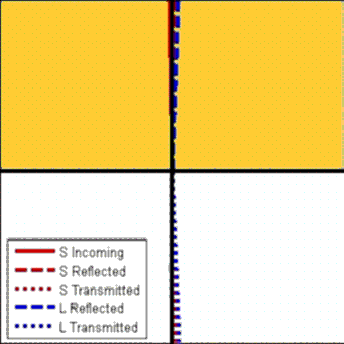Incident Medium Wave Speed Greater than the Receiving Medium Wave Speed with an Incident Longitudinal Wave
The animation below simulates an incident longitudinal wave on the boundary between two media. The incident medium has a higher wave speed than the receiving wave speed. The media simulated here are an aluminum incident medium and a copper receiving medium. As the angle of incidence increases (relative to normal incidence), one can observe the resulting mode conversion. Note that there are no critical angles in this situation.

Incident Medium Wave Speed Greater than the Receiving Medium Wave Speed with an Incident Shear Wave
The animation below simulates an incident shear wave on the boundary between two media. The incident medium has a higher wave speed than the receiving wave speed. The media simulated here are an aluminum incident medium and a copper receiving medium. As the angle of incidence increases (relative to normal incidence), one can observe the resulting mode conversion. Note that there are two critical angles in this situation. The first is seen for the reflected longitudinal wave, while the second is for the transmitted longitudinal wave.

Incident Medium Wave Speed Less than the Receiving Medium Wave Speed with an Incident Longitudinal Wave
The animation below simulates an incident longitudinal wave on the boundary between two media. The incident medium has a lower wave speed than the receiving wave speed. The media simulated here are a copper incident medium and an aluminum receiving medium. As the angle of incidence increases (relative to normal incidence), one can observe the resulting mode conversion. Note that there is one critical angles in this situation. The critical angle is seen for the transmitted longitudinal wave.

Incident Medium Wave Speed Less than the Receiving Medium Wave Speed with an Incident Shear Wave
The animation below simulates an incident shear wave on the boundary between two media. The incident medium has a lower wave speed than the receiving wave speed. The media simulated here are a copper incident medium and an aluminum receiving medium. As the angle of incidence increases (relative to normal incidence), one can observe the resulting mode conversion. Note that there are three critical angles in this situation. The first is seen for the transmitted longitudinal wave, while the second is for the reflected longitudinal wave, and finally the third is for the transmitted shear wave.
